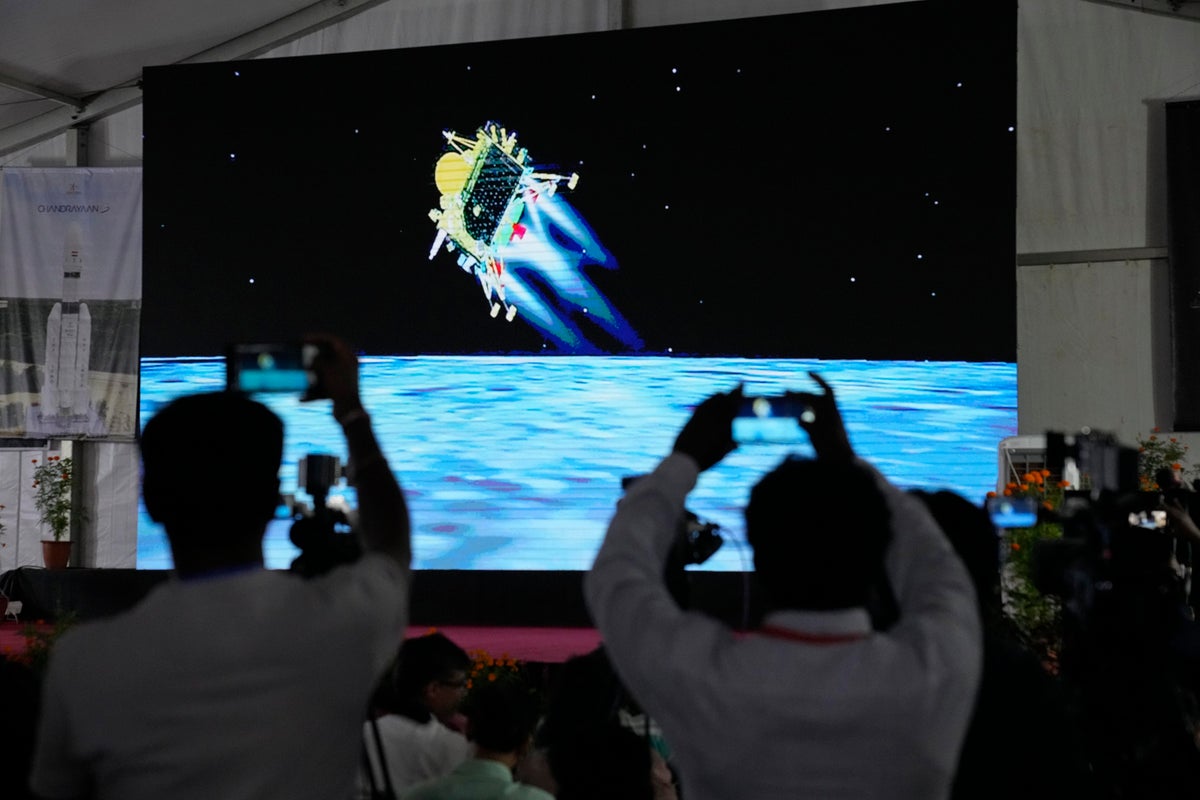
India has become the first country to reach the moon’s uncharted south pole, prompting Narendra Modi to claim victory in a new global space race.
“This moment is unforgettable,” the prime minister said as the Chandrayaan-3 lander completed a “soft landing” on the lunar surface. “It is phenomenal. This is a victory cry of a new India.”
It came days after Russia failed in a similar attempt in which its Luna-25 craft crashed and was destroyed, and means India joins an elite club of countries to reach the moon after the Soviet Union, the United States and China.
Follow The Independent’s live coverage of the launch here
“India is now on the moon!” Prime minister Modi told jubilant workers at the country’s ISRO space agency. “On this joyous occasion, I would like to address all the people of the world, the people of every country and region: India’s successful moon mission is not just India’s alone.”
Mr Modi said the mission’s research work would be done in a “human-centric spirit” and urged cooperation between nations to explore the “moon and beyond”.
“This success belongs to all of humanity, and it will help moon missions by other countries in the future,” he said.
The moon’s south pole is expected to become a key and contested region in the years to come. Research has shown that there is water ice waiting there – which could be important for allowing humans to live on the lunar surface.
If the Chandrayaan-3 mission’s Pragyan rover manages to find water ice on the lunar surface, it could begin a rush to use it as a resource to help extract fuel and oxygen from the moon.
Further detection and estimation of water ice on the lunar surface could raise hopes for a longer-term human presence on the moon, and facilitate future missions to explore other planets in the solar system.
Chandrayaan-3 has so far endured a long journey to the moon, blasting off on 14 July aboard the LVM3 rocket from India’s main spaceport, Sriharikota, in the southern state of Andhra Pradesh.
The mission is set to conduct science experiments on the lunar surface, whose cost comes to about £63m ($82m).
Instruments aboard the lander include a probe to measure the moon’s surface thermal properties, called Chandra’s Surface Thermophysical Experiment (ChaSTE), and one dubbed ILSA for measuring lunar seismic activity.
Apart from conducting ranging studies and analysing the gas and plasma environment of the moon, the mission is also expected to bring more investment to India’s growing number of space startups and institutes.
Russia’s space agency chief Yury Borisov said in an interview earlier this week that moon missions are “not just about the prestige of the country” but also of “practical value,” adding that “the race for the development of the natural resources of the moon has begun.”
“In the future, the moon will become a platform for deep space exploration, an ideal platform,” he said.
Nasa administrator Bill Nelson also said earlier this year that the US is in a new space race, hinting at the country’s technological competition with China.
“It is a fact, we’re in a space race,” Mr Nelson told Politico.
Nuclear-armed India grew to become the world’s fifth-largest economy last year, and the success of the lunar mission will likely provide a boost to Mr Modi’s popularity ahead of a crucial general election next year.
Across India, excited and anxious onlookers crowded around televisions in offices, shops, restaurants and homes. Thousands had prayed on Tuesday for the success of the mission, with oil lamps placed on river banks, in temples and in other religious places, including in the holy city of Varanasi in northern India.
Shrini Singh, a New Delhi resident, said she got goosebumps. “It's a very happy moment – you can see the energy. It's beyond words.”
Mitakshi Sinha, a student, said the successful mission motivated her. "And now I also want to be part of ISRO," she said, referring to the country's space agency.
India will host next month’s G20 summit, and Mr Modi is expected to use the event to spotlight the country's growing geopolitical clout. Even as it maintains historic ties with Russia, the West continues to woo India.







